#kritosaurus
Explore tagged Tumblr posts
Text
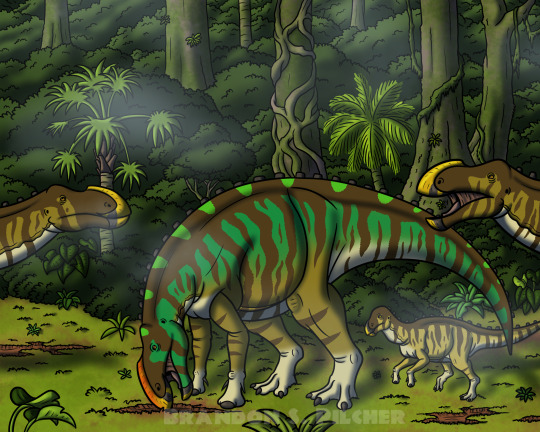
Kritosaurus at a Salt Lick
66 million years ago in Late Cretaceous North America, a herd of Kritosaurus navajovius gather around a salt lick in a jungle clearing. Licking minerals from the clay here provides these hadrosaurid dinosaurs with essential nutrients such as sodium, calcium, and zinc which helps with the animals’ physical growth. It’s a behavior many animals throughout the world carry out to this day.
#kritosaurus#hadrosaurids#dinosaurs#prehistoric#mesozoic#cretaceous#jungle#rainforest#paleoart#digital art#art
24 notes
·
View notes
Text
Coahuilasaurus lipani Longrich et al., 2024 (new genus and species)

(Type specimen of Coahuilasaurus lipani [scale bar = 20 cm], from Longrich et al., 2024)
Meaning of name: Coahuilasaurus = Coahuila lizard [in Greek]; lipani = for the Lipan Apache people
Age: Late Cretaceous (Campanian), around 72.5 million years ago
Where found: Cerro del Pueblo Formation, Coahuila, Mexico
How much is known: Partial skull of one individual. Skull fragments from at least one other individual may also belong to this species.
Notes: Coahuilasaurus was a hadrosaurid (duck-billed dinosaur). The type specimen was formerly considered a specimen of Kritosaurus navajovius, which is otherwise known from the southwestern United States. However, this specimen noticeably differs from Kritosaurus in several ways, such as having a strongly downturned tip of the lower jaw. The authors of a new study thus reclassify it as a new genus and species, and consider it likely more closely related to Gryposaurus. Coahuilasaurus is estimated to have been about 8 m long in total body length.
Reference: Longrich, N.R., A.A. Ramírez Velasco, J. Kirkland, A.E. Bermúdez Torres, and C.I. Serrano-Brañas. 2024. Coahuilasaurus lipani, a new kritosaurin hadrosaurid from the upper Campanian Cerro del Pueblo Formation, northern Mexico. Diversity 16: 531. doi: 10.3390/d16090531
89 notes
·
View notes
Text
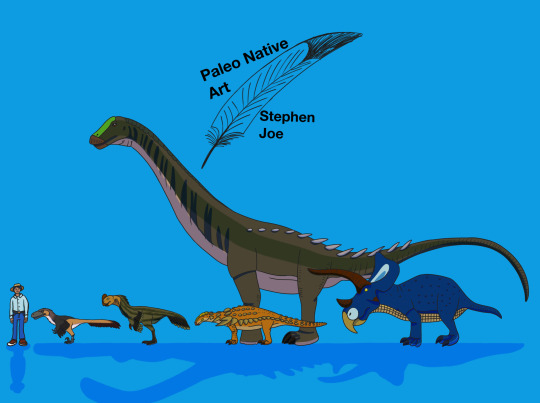
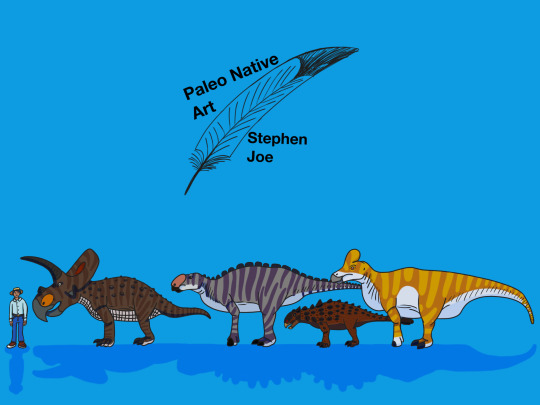

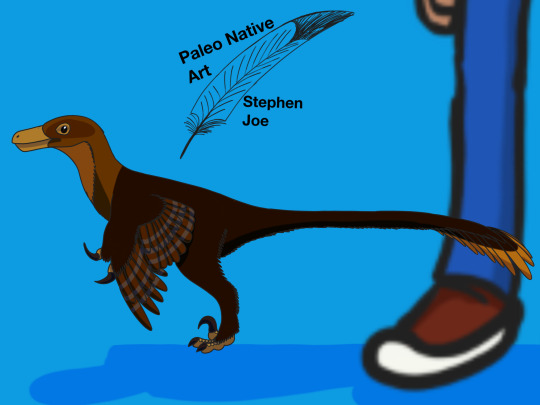
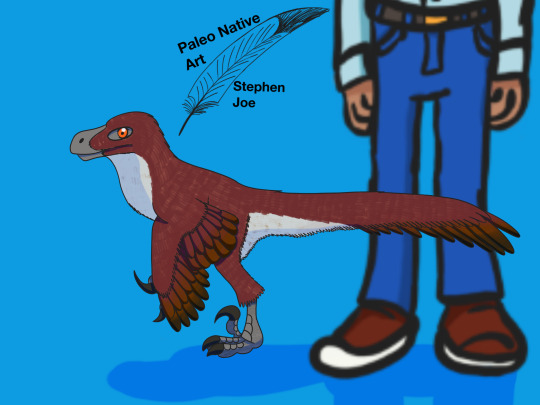
The Dinosaurs of the Ojo Alamo formation
Time for more to make a non-avian dinosaurs of the late Cretaceous period set in the heart of San Juan county, New Mexico. In fact, it’s very similar to northern laramidia such as Hell creek formation with subtropical warm and humid climate, and Lance formation with bayou environment. But unlike two other formations, Ojo Alamo formation has a lush floodplain dominated by wetlands and riparian forests. Home to the fossilized Cretaceous fishes, amphibians, turtles, squamates, crocodilians, and mammals.
As for the non-avian dinosaur species themselves, there were 5 species are officially valid (but one of them is possibly a nomen dubium). The rest however are indeterminate and unnamed species.
From left to right:
* Dineobellator notohesperus
* Ojoraptorsaurus boerei (nomen dubium as of 2025)
* Glyptodontopelta mimus
* Alamosaurus sanjuanensis
* Ojoceratops fowleri
As I said before, along with the other species of naashoibito member, they were unnamed or confer (Cf) other species of non-avian dinosaurs that were yet to describe.
From left to right (Herbivores side & Carnivores/Omnivores side)
* Ceratopsidae indet (An torosaurus-like chasmosaurine indet.)
* Hadrosauridae indet (Originally attended as Kritosaurus navajovius, but now its unknown species as “kritosaurini” indet.)
* Ankylosauridae indet (Noted as being similar to Ankylosaurus and Euoplocephalus.)
* Lambeosaurini indet (Noted as being similar to Corythosaurus and Hypacrosaurus.)
* Richardoestesia sp. (A few isolated teeth specimens.)
* Dromaeosauridae indet (An isolated teeth of the Saurornitholestinae indet similar to acheroraptor, but not as sharp as the latter.)
* Troodontidae indet (Isolated teeth specimens.)
* Ornithomimidae indet
* Tyrannosauridae indet (Formerly known as “Alamotyrannus brinkmanni.” Either Cf. Tyrannosaurus sp or possibly a new taxon species that is similar to Bistahieversor as closely related.)
For last but not surly least, it’s a same navajo man from my previous old art is back as sized scale for larger and smaller scale projects.
But the only these two are still there but ultimately not included were Caenagnathidae indet and Ankylosauria (possibly Nodosauridae) indet, due to both similarities of Ojoraptorsaurus and Glyptodontopelta which are distinct from other species.
Used skeletons of different species as references, belongs to Scott Hartman, Fadeno, GetAwayTrike, Jaime A. Headden, LancianIdolatry, Greg S. Paul, and Henry Sharpe Art.
#my art#myart#dinosaur#paleoart#my drawings#dinosaurs#dinosauria#ojo alamo formation#late cretaceous#theropod#sauropod#ornithischians#naayéé#navajo#sketchbook app#artists on tumblr#paleontology#fossil friday
12 notes
·
View notes
Text
Wordplay Wednesday: Index Fossil
Trilobites have come up a bunch this month and on Monday I mentioned they were used to date certain rocks. We call these kinds of fossils index fossils.
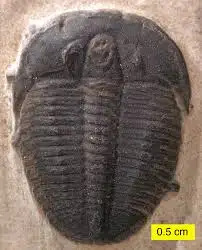
Now, not everything can be an index fossil. There are some very important qualities needed to be considered an index fossil.
1.) They must be distinctive and easily recognizable.

Look at how easy it is to identify different trilobites (and this is an incredibly small selection of the thousands of types out there).

However, if you were to look at hadrosaurinae, it is very difficult to tell Kritosaurus from Gryposaurus from Brachylophosaurus.
2.) They must be widespread. Trilobites can be found on every continent including Antarctica. In contrast, hadrosaurs have not been found in Africa or Australia so they are not very widespread.

3.) They must be abundant. There are over 22,000 kinds of trilobites while there are only about 60 kinds of hadrosaurs. Not even a competition there.
4.) They must live in a limited amount of geologic time. That means they can only be found in like one stage rather than an entire Era. Each of the 22,000 trilobites out there has their own distinct time they lived. For example, Elrathia lived from 513-499 Ma while Walliserops lived from 407-388 Ma.

Some may argue that hadrosaurs have a fighting chance here. Gryposaurus only lived from 80-75 Ma. That's a short time. We could use them to date rocks. But guess who else lived within that time frame?

Maiasaura.
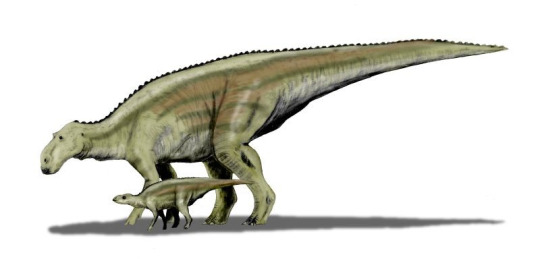
Kritosaurus.

Hadrosaurus.
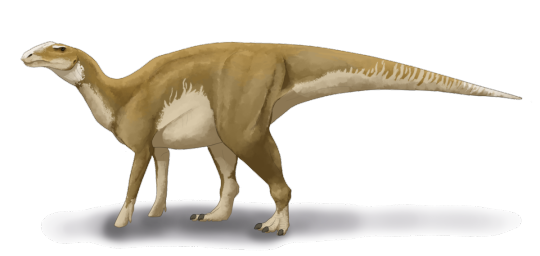
Brachylophosaurus.

Corythosaurus.
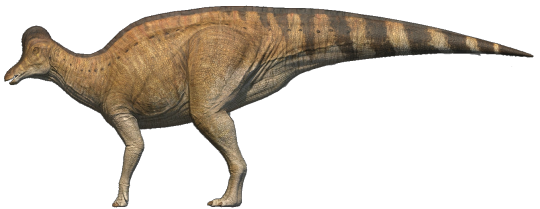
The list goes on. So, as you can see, dinosaurs do not make good index fossils but trilobites make great ones.
Fossilize you later!

17 notes
·
View notes
Note
I feel that's unfair, we don't know that Saurolophines *weren't* musical, we just know that Lambeosaurines definitely *were*. Heck, Kritosaurus et al have their honky noses, and they're Saurolophines!
have you put any thought into what common names dinosaurs would be given? obviously they all have Latin ones but like what about English ones?
well that's a complicated question isn't it
common names in English are derived from a variety of sources because English is a frankenlanguage
yeah sure it's "germanic" but we all know it has heavy latin elements and even some greek because of a variety of reasons and because it was the language of colonizers it was constantly adopting loan words and then you add on that the most followed religion of people who speak said language (and the official religion of the country where it began) is ultimately derived from a people who speak yet another language (Hebrew) so a lot of loan words come from that and now you have the internet age where everyone is talking to everyone else and tons of other loan words are being adopted in and on top of THAT you have the fact that the germanic invaders of the island where English was invented in the first place conquered people of the Celtic language group so then you can add in some but not a lot of Celtic words and -
that is just a very long way of saying where we get common names is complicated as fuck
for example. the word "bird". it didn't originally mean something biological (as Linnaeus defined it). it comes from the Old English word bridd, which means chick or BABY bird. birds are such babies we took the word for their babies and just called them all that. before that point fowl was the word for birds most of the time. fowl comes from the Old English fugol which is in a word family with the words for fleeing and flight.
let me put it this way: we will never know what kinds of names extinct dinosaurs would have been given because they were not around with people to associate concepts with in order to create names for them. some nonavian dinosaurs would have even been lumped with birds while others would have been lumped with "beasts". common names are steeped in history and can't just be made up on the fly without knowledge of how people would have interacted with them and conceptualized them within cultures.
100 notes
·
View notes
Text
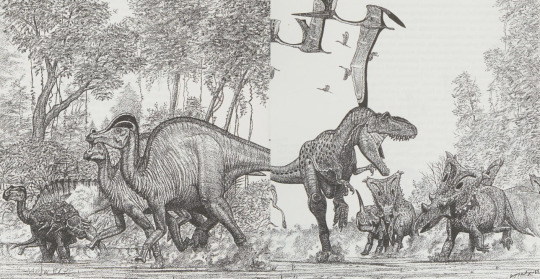
Predatory Dinosaurs of the World: A Complete Illustrated Guide. Written and drawn by Gregory Paul. 1989.
Internet Archive
#prehistoric#dinosaurs#theropods#tyrannosaurs#daspletosaurus#ornithopods#ceratopsians#monoclonius#chasmosaurus#hadrosaurs#hypacrosaurus#kritosaurus#ankylosaurs#edmontonia#prehistoric reptiles#pterosaurus#quetzalcoatlus#predation#Gregory Paul
87 notes
·
View notes
Photo
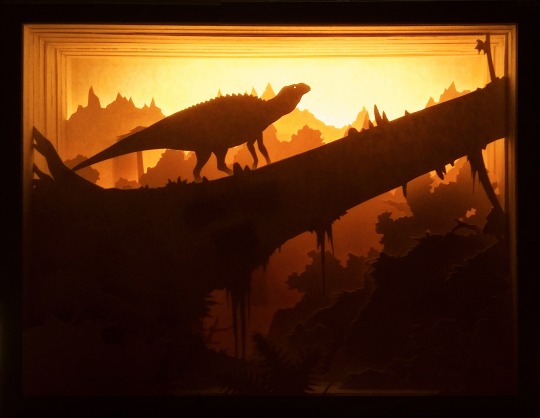


It’s another lightbox! I actually made this one first, but I forgot about it so here it is now! A Kritosaurus, separated from its herd, crosses a sequoia bridge through the forest. The lone herbivore continues to search for the safety of its group as evening falls. Being alone in a Campanian forest at night is not a good idea.
Thank you all so much for your enthusiasm about the last lightbox post, it’s something I really enjoy doing so I’m glad y’all like seeing it too! I’ve included another ‘process’ kinda photo with this one, so you can see all the different layers that make up this piece! This one has nine, I generally keep the layer count under ten because one you get up to that point the light just doesn’t really come through the paper any more so it’s pretty much pointless. This one had the added bonus of the foam board at the bottom of the scene kinda looking like the surface of a creek, which was not intentional but I think it looks nice!
#dinosaur#kritosaurus#cretaceous#palaeoart#paleoart#palaeontology#paleontology#palaeoblr#lightbox#papercraft
1K notes
·
View notes
Text

A Mexican Kritosaurus
This saurolophine hadrosaur hailing from the Cerro del Pueblo Formation (73-71 million years ago) which is part of the Sabinas Basin in Mexico, was originally described as Kritosaurus sp. by Kirkland et al. in 2006, but was later described as an indeterminate saurolophine by Prieto-Márquez et al. seven years later. This Mexican kritosaur is unique for sporting a ndistinctively curved ischium, and at 11 meters or 36 feet long, this Mexican Kritosaur was 20% larger than other species of the genus Kritosaurus, making it one of the largest saurolophines ever documented from North America. It shared its coastal wetland habitat, which spanned the southern coast of Laramidia, with other large herbivores such as fellow saurolophine Latirhinus uitstlani, the lambeosaurines Velafrons coahilensis and Tlatolophus galorum, and the chasmosaurine ceratopsian Coahuilaceratops magnacuerna.
29 notes
·
View notes
Photo

‘Beak lizards, who have strange head ornaments.
Top: Helmet lizard and hawk lizard.
Bottom: Cone lizard and crown lizard.’
Fortidsdyr I Farver, 1957 Finnish edition
Kai Petersen Illustrated by Verner Hancke
'Most extinct animals have only scientific names, Greek or Latin. Because of that the author of the original (Danish) edition invented Danish names for the animals. Finnish versions of those names have been used in this edition except for those (very rare) cases where an animal already has a Finnish name.'
126 notes
·
View notes
Text

Huallasaurus
Huallasaurus — рід зауролофінових гадрозаврів з пізньої крейди Лос-Аламітоської формації в Аргентині (Патагонія). Типовий і єдиний вид — H. australis. Спочатку названий як вид Kritosaurus в 1984 році, він довго вважався синонімом Secernosaurus, перш ніж був визнаний окремим родом у дослідженні 2022 року, відмінним від інших представників Kritosaurini.
Повний текст на сайті "Вимерлий світ":
https://extinctworld.in.ua/huallasaurus/
#huallasaurus#argentina#patagonia#cretaceous#late cretaceous#cretaceous period#kritosaurus#kritosaurini#secernosaurus#paleoart#paleontology#prehistoric#палеоарт#палеонтологія#extinct animals#доісторичні тварини#вимерлі тварини#ukraine#ukraineposts#made in ukraine
4 notes
·
View notes
Photo

#Kritosaurus #Secernosaurus - Dibujo en grafito y lápiz blanco sobre papel gris / Graphite and white pencil over gray paper https://www.instagram.com/p/B6MJNhjlZ2s/?igshid=1lrqzlf97bw5w
2 notes
·
View notes
Photo

This unfortunate Kritosaurus navajovius is about to have a hungry Tyrannosaurus rex crunching down on its neck!
Most of the time, when you see a T. rex going after hadrosaurs in paleoart, the prey is Edmontosaurus. I wanted to shake things up a bit by having the unlucky hadrosaur be Kritosaurus, from the southern half of T. rex’s range, instead.
#tyrannosaurus rex#kritosaurus#hadrosaur#dinosaurs#prehistoric#mesozoic#cretaceous#paleoart#digital art#art
6 notes
·
View notes
Photo

I’m back to drawing scaly hadrosaurid such as New Mexico’s Kritosaurus navajovius to celebrate the #nationaldinosaurday on this day. #kritosaurusnavajovius #kritosaurus #kritosaurini #naayéé #dinosauria #hadrosauridae #ornithopoda #sketchbook #paleoart #artistsoninstagram #artistontumblr #myart https://www.instagram.com/p/CAOZgvxlOdx/?igshid=1g7sjurs1wb9c
#nationaldinosaurday#kritosaurusnavajovius#kritosaurus#kritosaurini#naayéé#dinosauria#hadrosauridae#ornithopoda#sketchbook#paleoart#artistsoninstagram#artistontumblr#myart
1 note
·
View note
Text

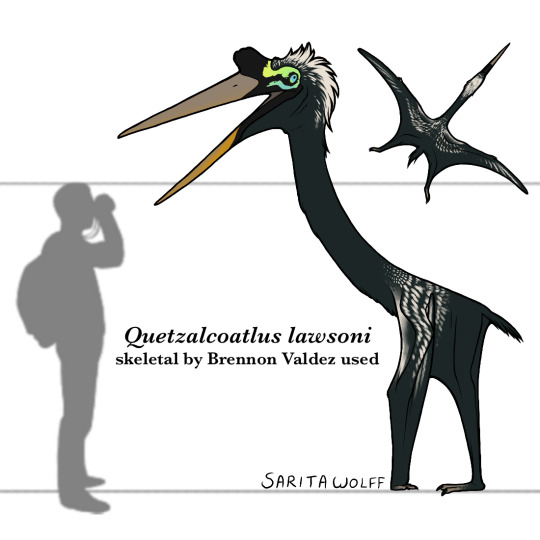
#Archovember Day 28 - Quetzalcoatlus lawsoni
While most people now know of the giraffe-sized Quetzalcoatlus northropi, the smaller species deserves much more credit. Most of what we know about the giant Q. northropi comes from lawsoni: northropi is known only from cervical vertebrae and some fragments of wing. We have filled in the rest using the anatomy of the smaller species, Q. lawsoni, of which much more material is known. For years Q. lawsoni wasn’t even named (as it was uncertain whether it was a juvenile or a seperate species). It was just known as Quetzalcoatlus sp. or “the smaller Quetzalcoatlus”. Finally, lawsoni was determined to be an adult and a separate species from northropi, and recieved a name in late 2021.
Even if it wasn’t the size of a giraffe, Quetzalcoatlus lawsoni was still a large, formidable azhdarchid! It had an estimated wingspan of 5 m (16 ft), body length of 3.5 m (11 ft), body mass of 65 kg (143 lb), and a long, sharp, pointed beak. It was native to Late Cretaceous North America, particularly Texas, where it coexisted with the other azhdarchid Wellnhopterus. It has been suggested that Quetzalcoatlus would have filled a similar niche to the modern Marabou Stork: a terrestrial scavenger and predator of small animals that could still fly in a pinch. Having unique fore and hindlimb proportions, Quetzalcoatlus seems adapted to a terrestrial lifestyle, and was even capable of “galloping.”
Alongside fellow azhdarchids Wellnhopterus and its larger cousin Q. northropi, Quetzalcoatlus lawsoni lived alongside the titanosaur Alamosaurus, the ceratopsids Bravoceratops and Torosaurus, the hadrosaurs Kritosaurus and Saurolophinae, the dromaeosaur Saurornitholestes, the troodontid Troodon, and of course, the tyrannosaurid Tyrannosaurus rex. It would have fed on a variety of small mammals, reptiles, and perhaps even birds and their eggs.
987 notes
·
View notes
Text
Ajnabia vs Tlatolophus
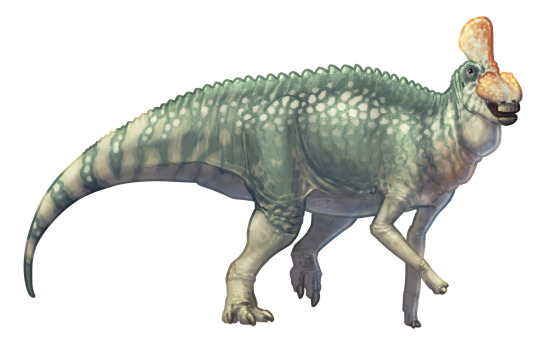

Factfiles:
Ajnabia odysseus

Artwork by @i-draws-dinosaurs, written by @zygodactylus
Name Meaning: Great Seafarer Stranger
Time: 68 to 66 million years ago (Maastrichtian stage of the Late Cretaceous)
Location: Upper member of the Couche III Formation, Ouled Abdoun Basin, north-central Morocco
Ajnabia is an extremely small (possibly the smallest) hadrosaur, specifically a European lambeosaurine. Finding one in Morocco was a legitimate surprise discovery, since northern Africa was fully separated from Europe by ocean at the time. Known from parts of the jaw, most of what we know about it is inferred from its probable close relatives, the North African-European Maastrichtian hadrosaurs - though the crests of these animals are not well known, it is presumable they for the group would have been hollow and shaped in different ways to produce different sounds based on species, including Ajnabia. As in other hadrosaurs, it would have been robust, with long robust and stiff tails, muscular hind limbs with three toed feet, and strong slender forelimbs ending in weird hoof-like structures. They also had rows and rows of densely packed teeth built for grinding through a variety of vegetation. It probably got from Eurasia to Africa via oceanic dispersal, possibly even swimming from one landmass to another. At less than four meters long, it would have been dwarfed by its newfound neighbors, large dinosaurs such as the abelisaurid Chenanisaurus, and a yet-unnamed titanosaur. There were also, of course, azhdarchids in the form of Phosphatodraco and pteranodontid Tethydraco, and three separate types of Nyctosaurids - Alcione, Simurghia, and Barbaridactylus (you may recognize this lineup from a certain paleo doc). On the ocean side of things, mosasaurs, elasmosaurs, sharks, fish, and other marine life filled the seas to the brim, making it even more of a wonder that Ajnabia got over to Morocco safely!
Tlatolophus galorum

Artwork by Joaquin Eng Ponce, written by @zygodactylus
Artwork by Joaquin Eng Ponce, written by Meig
Name Meaning: Gazra and López’s Word Crest
Time: 73 million years ago (Campanian stage of the Late Cretaceous)
Location: Cerro del Pueblo Formation, Coahuila, Mexico
Tlatolophus was a Lambeosaur - so another crested hadrosaur - from Mexico, a place that we don’t talk about the fossils of nearly enough! The most complete Lambeosaur known from Mexico, the skull and large portions of the skeleton are known, including the tail. At about 8 meters long, Tlatolophus had a tall skull and thick tail, and the usual hooved front feet of hadrosaurs. Its crest was long, low, and angled backwards, much like the glyph for “word” in Aztec writings - hence its name! Given the unique shape, it probably made a unique sound, different from other hadrosaurs. Interestingly, it actually seems to have been closely related to Parasaurolophus and its relatives, making it another member of the Parasaurolophini group! As a hadrosaur, it would have been a social animal, with behaviors such as communal nature and communication. The Cerro del Pueblo formation was a coastal ecosystem, filled with a variety of unnamed dinosaurs, but also Coahuilaceratops, Kritosaurus, Latirhinus, Velafrons, Paraxenisaurus (the first potential Deinocheirid from North America), as well as pterosaurs, turtles, fish, and multituberculate mammals.
DMM Round One Masterpost
#dmm#dinosaur march madness#dmm round one#dmm rising stars#palaeoblr#dinosaurs#paleontology#bracket#march madness#polls#ajnabia#tlatolophus
106 notes
·
View notes
